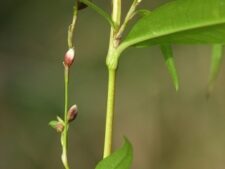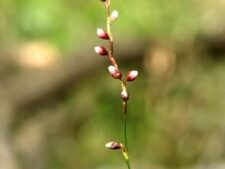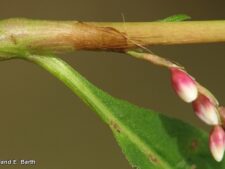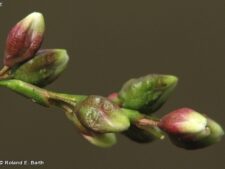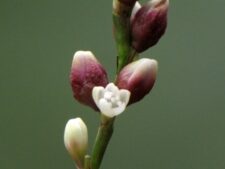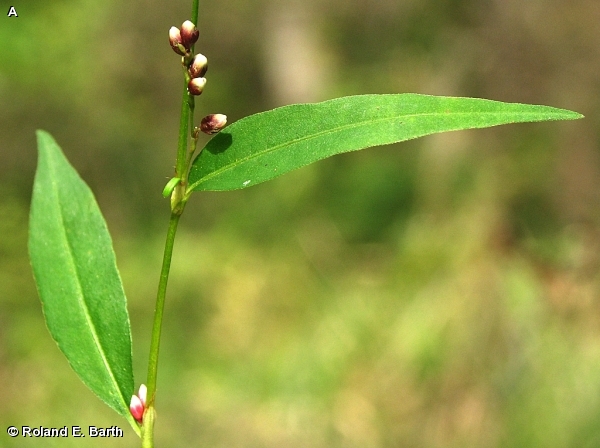
WATER-PEPPER
Persicaria hydropiper
BUCKWHEAT FAMILY (Polygonaceae)
 Identification
Identification
- Flowering from June to October
- Uncommon on floodplain at FF
- Papery sheaths cover stem at the base of each leaf
- Tiny, dot-like pits on flower buds
- Some (not all) flower stalks arising from under the papery joint sheaths
Not all botanists agree on the origin of this annual plant. Many believe it was introduced from Eurasia; others think it is native. Its stems may be erect (A,B) or sprawling. Lance-shaped stalkless or short-stalked leaves emerge from papery sheaths (ocrea) which have long, straight bristles on their margins (D). Stalks hold loosely arranged flowers originating either from the tips of branched stems (B,C) or the leaf axils (D). The tiny 1/8 inch flowers have 5, sometimes 4, tepals (petals and sepals that look alike). Tepals are white or greenish-white when open (F), but the outer portions of the budlike, unopened tepals may be tinged with pink (D,F). The outer surface of the tepals is also pitted with tiny glands (E) (a hand lens may be needed to see them).
The pitted outer surface of the flower buds separate this member of the Persicaria genus (Smartweeds) from all others except for P. punctatum (Dotted Smartweed). Separating these 2 can be a challenge and that magnifying lens you used to ID the pitted tepals will be helpful! Only Water Pepper will have flower stalks arising from the under the sheath at the base of the leaf (axil). Also, some Water Pepper plants may have flowers with 4 petals or pinkish unopened flower buds (tepals), helpful features when present. Water Pepper’s tiny seeds are also pitted and duller than the shiny black seeds of Dotted Smartweed.
This species is uncommon on the floodplain in or near water in Fontenelle Forest. It has not been documented, but is likely at Neale Woods. The flowers bloom from July through October – images shown here were taken in early October.
This plant produces chemicals responsible for its pungent, bitter taste as well as its common names, Water Pepper and Marshpepper Knotweed. It is a member of a group of wetland plants collectively known as Smartweeds.
The genus name was recently changed from Polygonum to Persicaria.
The content of NatureSearch is provided by dedicated volunteer Naturalists of Fontenelle Forest who strive to provide the most accurate information available. Contributors of the images retain their copyrights. The point of contact for this page is: Roland Barth.

